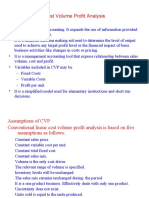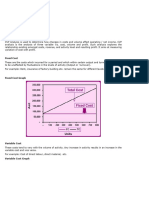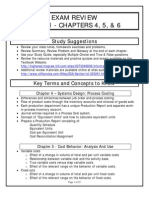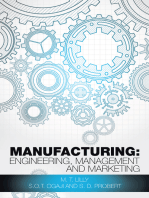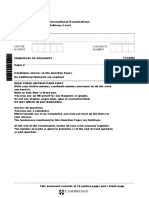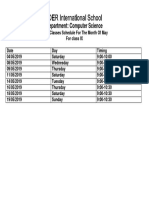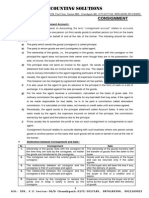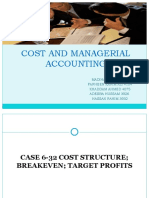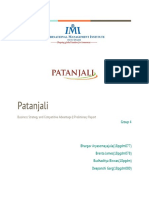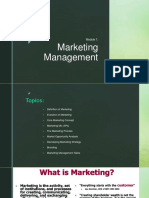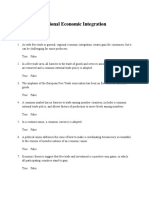Marginal and Absorption Costing 7: This Chapter Covers..
Marginal and Absorption Costing 7: This Chapter Covers..
Uploaded by
PontuChowdhuryCopyright:
Available Formats
Marginal and Absorption Costing 7: This Chapter Covers..
Marginal and Absorption Costing 7: This Chapter Covers..
Uploaded by
PontuChowdhuryOriginal Description:
Original Title
Copyright
Available Formats
Share this document
Did you find this document useful?
Is this content inappropriate?
Copyright:
Available Formats
Marginal and Absorption Costing 7: This Chapter Covers..
Marginal and Absorption Costing 7: This Chapter Covers..
Uploaded by
PontuChowdhuryCopyright:
Available Formats
7
Marginal and
absorption costing
this chapter covers...
This chapter focuses on the costing methods of marginal and absorption costing and
compares the profit made by a business under each method. The chapter concludes
with the layout of a manufacturing account and statement of profit or loss (income
statement) and where the different types of inventory raw materials, work-in-progress,
finished goods are shown in the financial statements.
This chapter explains:
n the different treatment of product costs and period costs in marginal costing and
absorption costing
n how marginal costing works, including the calculation of contribution, and its role in
short-term decision-making
n how absorption costing works, including the valuation of closing inventory
n a comparison of profits when marginal costing and absorption costing are used
n the layout of
a manufacturing account to show production cost
a statement of profit or loss to show profit for the year
marginal and absorption costing
201
marginal and absorption costing systems
These two costing systems are often used in cost accounting, but for different
purposes:
n marginal costing helps with short-term decision-making
n absorption costing is used to calculate inventory valuations and profit
calculations in financial statements
The use of each system is dependent on the information needs of the business
or organisation:
can we afford to sell 1,000 units of our product each month to
Megastores Limited at a discount of 20 per cent? (use marginal
costing)
what profit have we made this year? (use absorption costing)
These costing systems use the same costs, but they are treated differently
according to their behaviour. We will now look at each of these costing
systems in turn and then make a comparison between them.
marginal costing
Marginal cost is the cost of producing one extra unit of output
To help with short-term decision-making, costs are classified by their
behaviour as either variable costs or fixed costs (with semi-variable costs
being split between their fixed and variable parts). Such a classification of
costs is used in marginal costing to work out how much it costs to produce
each extra unit of output.
Marginal cost is often but not always the total of the variable costs of
producing a unit of output. For most purposes, marginal costing is not
concerned with fixed period costs (such as the rent of a factory); instead it is
concerned with variable product costs direct materials, direct labour, direct
expenses, and variable production overheads which increase as output
increases. For most decision-making, the marginal cost of a unit of output is,
therefore, the variable cost of producing one more unit.
Knowing the marginal cost of a unit of output enables the managers of a
business to focus on the contribution provided by each unit. The contribution
is the sales revenue after marginal/variable product costs have been paid. The
contribution formula is:
selling price less variable cost = contribution
202
analysing costs and revenues tutorial
Contribution can be calculated on a per unit basis (as here), or for a batch of
output (eg 1,000 units), or for a whole business.
It follows that the difference between the sales revenue and the variable costs
of the units sold in a period is the total contribution that the sales of all the
units in the period make towards the fixed period costs of the business. Once
these are covered, the remainder of the contribution is profit.
Thus a business can work out its profit, using a marginal costing statement,
for any given period from the total contribution and fixed costs figures:
total contribution less total fixed costs = profit
A marginal costing statement can be prepared in the following format:
Sales revenue
less
equals
less
equals
Variable costs
Contribution
Fixed costs
PROFIT
Note from the marginal costing statement how the contribution goes firstly
towards the fixed costs and, when they have been covered, secondly
contributes to profit.
The relationship between marginal costing, contribution and profit is shown
in the Case Study which follows.
Case
Study
W Y V E R N B I K E C O M PA N Y: M A R G I N A L C O S T I N G
situation
The Wyvern Bike Company makes 100 bikes each week and its costs are as follows:
Direct materials
Direct labour
Production overheads
4,000
5,000
5,000
Investigations into the behaviour of costs has revealed the following information:
direct materials are variable costs
direct labour is a variable cost
of the production overheads, 2,000 is a fixed cost, and the remainder is a variable
cost
The selling price of each bike is 200.
marginal and absorption costing
203
As an accounts assistant at the Wyvern Bike Company, you are asked to:
calculate the marginal cost of producing each bike
show the expected contribution per bike
prepare a marginal costing statement to show clearly the total contribution and the
total profit each week
solution
Marginal cost per bike
Variable costs per unit:
Direct materials (4,000 100)
40
Direct labour (5,000 100)
50
Production overheads (3,000* 100)
30
Marginal cost per bike
120
* 5,000 2,000 fixed costs
Contribution per bike
less
equals
Selling price per bike
Variable cost per bike
Sales 200 x 100 bikes
Variable costs:
Direct materials
Direct labour
Production overheads
equals
less
equals
120
Contribution per bike
Marginal costing statement
less
200
Total contribution
Fixed costs (production overheads)
Profit for the week
80
20,000
4,000
5,000
3,000
12,000
8,000
2,000
6,000
204
analysing costs and revenues tutorial
advantages of a marginal costing statement
A marginal costing statement is of benefit to the managers of a business
because:
n contribution, ie selling price less variable cost, is clearly identified
n with the marginal cost of output identified, the managers can focus on the
contribution provided by the output
n the effect on costs of changes in sales revenue can be calculated
n it helps with short-term decision-making in the forms of
break-even analysis
margin of safety
target profit
contribution sales ratio
limiting factors
special order pricing
We will look at the role of marginal costing in short-term decision-making in
Chapter 9.
absorption costing
Absorption costing absorbs the costs of the business amongst the cost
units.
Absorption costing answers the question, What does it cost to make one unit
of output?
The absorption cost of a unit of output is made up of the following costs:
add
add
add
equals
Direct materials
Direct labour
Direct expenses
Production overheads (fixed and variable)
ABSORPTION COST
Note that the production overheads comprise the factory costs of indirect
materials, indirect labour, and indirect expenses.
marginal and absorption costing
Case
Study
205
W Y V E R N B I K E C O M PA N Y: A B S O R P T I O N C O S T I N G
situation
The Wyvern Bike Company makes 100 bikes each week and its costs are as follows:
Direct materials
Direct labour
Production overheads
The selling price of each bike is 200.
4,000
5,000
5,000
As an accounts assistant at the Wyvern Bike Company, you are asked to:
calculate the absorption cost of producing each bike
calculate the total profit each week
solution
Absorption cost per bike
Total costs per week:
Direct materials
4,000
Production overheads
5,000
Direct labour
5,000
Total cost
The absorption cost of producing one bike is:
Total cost
Units of output
Profit each week
less
equals
14,000
100 bikes
14,000
= 140 per bike
Selling price (100 bikes x 200)
Total cost
Profit for the week
20,000
14,000
6,000
Conclusion
Profit for the week of 6,000 is the same as with the marginal costing method, so we
could say Does it matter whether we use marginal or absorption costing? The answer
to this is that it does:
marginal costing, with its focus on variable costs and contribution, is useful for shortterm decision-making
absorption costing is a simple method of calculating the cost of output and is used
in financial statements for inventory valuation
206
analysing costs and revenues tutorial
As the Case Study shows, each cost unit bears an equal proportion of the
costs of the production overheads of the business. Because of its simplicity,
absorption costing is a widely used system which tells us how much it costs
to make one unit of output. It works well where the cost units are identical,
eg 100 identical bikes, but is less appropriate where some of the cost units
differ in quality, eg 100 bikes, of which 75 are standard models and 25 are
handbuilt to the customers specifications. It also ignores the effect of
changes in the level of output on the cost structure. For example, if the bike
manufacturer reduces output to 50 bikes a week:
n will direct materials remain at 40 per bike? (buying materials in smaller
quantities might mean higher prices)
n will direct labour still be 50 per bike? (with lower production, the
workforce may not be able to specialise in certain jobs, and may be less
efficient)
n will the production overheads remain at 5,000? (perhaps smaller
premises can be used and the factory rent reduced)
m a r g i n a l a n d a b s o r p t i o n c o s t i n g c o m pa r e d
Marginal costing tells the managers of a business or organisation the cost of
producing one extra unit of output. Nevertheless, we must always remember
that one of the objectives of the costing system is to ensure that all the costs
of a business or organisation are recovered by being charged to production.
This is achieved by means of overhead absorption (see Chapter 5). We will
now make a comparison between marginal and absorption costing:
n marginal costing
Marginal costing recognises that fixed period costs vary with time rather
than activity, and identifies the variable production cost of one extra unit.
For example, the rent of a factory relates to a certain time period, eg one
month, and remains unchanged whether 100 units of output are made or
whether 500 units are made (always assuming that the capacity of the
factory is at least 500 units); by contrast, the production of one extra unit
will incur an increase in variable costs, ie direct materials, direct labour,
direct expenses (if any), and variable overheads this increase is the
marginal cost.
n absorption costing
This technique absorbs all production costs into each unit of output
through the use of an overhead absorption rate (see Chapter 5). Therefore
the more units that are produced, the cheaper will be the cost per unit
because the overheads are spread over a greater number of units.
marginal and absorption costing
207
The diagram below demonstrates how the terms in marginal costing relate to
the same production costs as those categorised under absorption costing
terms. As noted above, when using marginal costing it is the behaviour of the
cost fixed or variable that is important, not the origin of the cost.
absorption costing
direct costs
direct materials
direct labour
direct expenses
indirect costs
variable overheads
fixed overheads
marginal costing
variable costs
variable direct materials
variable direct labour
variable direct expenses
variable overheads
fixed costs
fixed direct expenses
fixed overheads
The table on the next page gives a comparison between marginal costing and
absorption costing, including a note on the usefulness and the limitations of
each.
marginal and absorption costing: profit comparisons
Because of the different ways in which marginal costing and absorption
costing treat fixed period costs, the two techniques produce different levels
of profit when there is a closing inventory figure. This is because, under
marginal costing, the closing inventory is valued at variable production cost;
by contrast, absorption cost includes a share of fixed production costs in the
closing inventory valuation. This is illustrated in the Case Study which
follows, looking at the effect of using marginal costing and absorption
costing on the statement of profit or loss of a manufacturing business.
Note that the marginal cost approach is used to help with short-term
decision-making (see Chapter 9). However, for financial statements,
absorption costing must be used for inventory valuation purposes in order to
comply with IAS 2 (see page 44). Under IAS 2, Inventories, the closing
inventory valuation is based on the costs of direct materials, direct labour,
direct expenses (if any), and production overheads. Note that non-production
overheads are not included, as they are charged in full to the statement of
profit or loss in the year to which they relate.
208
analysing costs and revenues tutorial
COMPARISON OF MARGINAL AND ABSORPTION COSTING
marginal costing
absorption costing
how does
it work?
costs are classified as either
fixed or variable
contribution to fixed costs is
calculated as selling price
less variable costs
overheads are charged to
output through an overhead
absorption rate, often on the
basis of direct labour hours
or machine hours
main focus
marginal cost
contribution
all overheads charged to
output
calculating profit
calculating inventory values
usefulness
concept of contribution is
easy to understand
useful for short-term
decision-making, but no
consideration of overheads
acceptable under IAS 2,
Inventories
appropriate for traditional
industries where overheads
are charged to output on the
basis of direct labour hours
or machine hours
limitations
costs have to be identified as
either fixed or variable
all overheads have to be
recovered, otherwise a loss
will be made
not acceptable under IAS2,
Inventories
calculation of selling prices
may be less accurate than
other costing methods
not as useful in short-term
decision-making as marginal
costing
may provide less accurate
basis for calculation of
selling prices where
overheads are high and
complex in nature
main use
to help with short-term
decision-making (see
Chapter 9) in the forms of
break-even analysis
margin of safety
target profit
contribution sales ratio
limiting factors
special order pricing
to calculate profit
to calculate inventory
valuation for financial
statements
marginal and absorption costing
209
ChAIRS LIMITED:
MARGINAL AND ABSORPTION COSTING
Case
Study
situation
Chairs Limited commenced business on 1 January 20-7. It manufactures a special
type of chair designed to alleviate back pain. Information on the first years trading is
as follows:
number of chairs manufactured
number of chairs sold
5,000
4,500
selling price
110 per chair
direct labour
40 per chair
direct materials
30 per chair
fixed production overheads
100,000
The directors ask for your help in producing profit statements using the marginal
costing and absorption costing methods. They say that they will use the one that
shows the higher profit to the companys bank manager.
solution
cHairs limited
statement of profit or loss for the year ended 31 december 20-7
sales revenue at 110 each
marginal costing
Variable costs
Direct materials at 30 each
Direct labour at 40 each
Less Closing inventory (marginal cost)
500 chairs at 70 each
Fixed production overheads
Less Closing inventory (absorption cost)
500 chairs at 90 each
Less Cost of sales
proFit
150,000
495,000
200,000
absorption costing
150,000
495,000
200,000
350,000
35,000
315,000
100,000
100,000
450,000
415,000
80,000
45,000
405,000
90,000
210
analysing costs and revenues tutorial
Tutorial notes:
Closing inventory is always calculated on the basis of this years costs:
marginal costing, variable costs only, ie 30 + 40 = 70 per chair
absorption costing, variable and fixed costs, ie 450,000 5,000 chairs = 90 per
chair
The difference in the profit figures is caused only by the closing inventory figures:
35,000 under marginal costing and 45,000 under absorption costing the same
costs have been used, but fixed production overheads have been treated differently.
Only fixed production overheads are dealt with differently using the techniques of
marginal and absorption costing both methods charge non-production overheads
in full to the statement of profit or loss in the year to which they relate.
With marginal costing, the full amount of the fixed production overheads has been
charged in this years statement of profit or loss; by contrast, with absorption costing,
part of the fixed production overheads (here, 10,000) has been carried forward in the
inventory valuation.
With regard to the directors statement that they will use the one that shows the higher
profit, the following points should be borne in mind:
A higher profit does not mean more money in the bank.
The two methods simply treat fixed production overheads differently and, in a year
when there is no closing inventory, total profits to date are exactly the same but
they occur differently over the years. Over time, profits are identical under both
methods.
For financial statements, Chairs Limited must use the absorption cost inventory
valuation of 45,000 in order to comply with IAS 2, Inventories.
t H e u s e o F a m a n u Fa c t u r i n g a c c o u n t
Now that we have seen how a manufacturing business uses absorption
costing to value its closing inventory, we can turn our attention to the yearend financial statements and, in particular, the use of a manufacturing
account.
For preparing financial statements a business needs to have an accounting
system that records the costs and revenues for its output, and then shows the
profit or loss that has been made for the accounting period. For a business
such as a retailer that buys and sells goods, without carrying out any
production processes, the accounting system is relatively simple the figure
for revenue is deducted from the amount of purchases (after allowing for
changes in the value of opening and closing inventories) and the amount of
overheads; a profit is made when revenue exceeds the total costs. For a
marginal and absorption costing
211
manufacturer, though, the costs are more complex as they comprise the direct
and indirect costs of materials, labour and expenses; also, a manufacturer
will invariably have opening and closing inventory in three different forms
direct materials, work-in-progress and finished goods.
In its year-end financial statements a manufacturer prepares:
n a manufacturing account, which shows production (factory) cost
n a statement of profit or loss, which shows profit for the period
The financial statements, which are part of the double-entry system, use the
following outline:
MANUFACTURING
ACCOUNT
add
add
equals
add
equals
STATEMENT OF
PROFITORLOSS
less
equals
less
Direct materials
Direct labour
Direct expenses
PRIME COST
Production overheads
PRODUCTION (FACTORY) COST
Sales revenue
Production (factory) cost
GROSS PROFIT
Non-production overheads, eg
selling and distribution expenses
administration expenses
equals
finance expenses
PROFIT FOR ThE PERIOD
notes
n Adjustments have to be made to allow for changes in the value of
inventory at the start of the accounting period (opening inventory) and at
the end of the accounting period (closing inventory) for:
direct materials, in the manufacturing account
work-in-progress (or partly manufactured goods), in the
manufacturing account
finished goods, in the statement of profit or loss
212
analysing costs and revenues tutorial
n The statement of profit or loss shows two levels of profit:
gross profit, the difference between selling price and production cost
(after allowing for changes in the value of opening and closing
inventory)
profit for the year, the profit after all costs have been deducted and
which belongs to the owner(s) of the business
n Certain expenses might be apportioned on an appropriate basis between
the manufacturing account and the statement of profit or loss for
example, rent and rates might be apportioned 75 per cent to the factory
(production overheads) and 25 per cent to the office (non-production
overheads)
An example of a manufacturing account and statement of profit or loss is
shown on the next page.
Chapter
Summary
n Marginal costing classifies costs by their behaviour variable product costs
or fixed period costs. Such a classification is used to cost units of output on
the basis of their variable (or marginal) costs.
n Marginal costing helps with short-term decision-making.
n Absorption costing absorbs the costs of the business amongst the cost units
by means of overhead absorption rates. It is used to cost units of output to
calculate inventory valuations for financial statements and to calculate profit.
n A manufacturing account is a financial statement which shows prime cost and
production (factory) cost.
n A statement of profit or loss shows non-production overheads and profit for
the year of the business.
Key
Terms
marginal cost
contribution
absorption cost
manufacturing account
the cost of producing one extra unit of
output
selling price variable cost
the costs of the business are absorbed
amongst the cost units through the use of
an overhead absorption rate
an account part of the double-entry
system which brings together the
elements of cost that make up production
(factory) cost
marginal and absorption costing
213
ALPHA MANUFACTURING COMPANY
MANUFACTURING ACCOUNT AND STATEMENT OFPROFITORLOSS
for the year ended 31 December 20-4
Opening inventory of direct materials
Add Purchases of direct materials
6,000
DIRECT MATERIALS USED
49,000
Direct labour
26,000
Direct expenses
Add
Production (factory) overheads:
Indirect materials
Indirect labour
Indirect expenses:
Rent of factory
Depreciation of factory machinery
Factory light and heat
2,500
2,000
5,000
10,000
4,000
4,000
3,000
PRODUCTION (FACTORY) COST OF GOODS MANUFACTURED
Production (factory) cost of goods manufactured
Less Closing inventory of finished goods
COST OF SALES
Gross profit
Less
Non-production overheads:
Selling and distribution expenses
Administration expenses
Finance expenses
Profit for the year
37,000
114,500
118,500
Less Closing inventory of work-in-progress
Opening inventory of finished goods
77,500
16,000
Add Opening inventory of work-in-progress
Sales revenue
5,000
50,000
55,000
Less Closing inventory of direct materials
PRIME COST
115,500
6,500
115,500
122,000
7,500
38,500
32,000
3,500
195,500
114,500
81,000
74,000
7,000
Note: a layout for a manufacturing account and statement of profit or loss is given in the
Appendix.
214
analysing costs and revenues tutorial
Activities
7.1
Coffeeworks Limited manufactures coffee machines for domestic use. The management of the
company is considering next years production and has asked you to help with certain financial
decisions.
The following information is available:
Selling price (per machine)
Direct materials (per machine)
Direct labour (per machine)
Fixed production overheads
80
25
20
270,000 per year
The company is planning to manufacture 15,000 coffee machines next year.
(a)
(b)
(c)
7.2
calculate the marginal cost per coffee machine
calculate the absorption cost per coffee machine
prepare a statement of profit or loss to show the profit or loss if 15,000 coffee machines are
sold
Cook-It Limited makes garden barbecues. The management of the company is considering the
production for next year and has asked for help with certain financial decisions.
The following information is available:
Selling price (per barbecue)
Direct materials (per barbecue)
Direct labour (per barbecue)
Fixed production overheads
90
30
25
150,000 per year
The company is planning to manufacture 10,000 barbecues next year.
required
You are to calculate:
the marginal cost per barbecue
the absorption cost per barbecue
the profit or loss if 10,000 barbecues are sold
marginal and absorption costing
7.3
215
Maxxa Limited manufactures one product, the Maxx. For the month of January 20-7 the following
information is available:
Number of units manufactured
4,000
Number of units sold
3,000
Selling price
8 per unit
Direct materials for month
5,000
Direct labour for month
9,000
Fixed production overheads for month
6,000
There was no finished goods inventory at the start of the month. Both direct materials and direct
labour are variable costs.
required:
You are to produce statements of profit or loss using marginal costing and absorption costing
methods.
7.4
Activtoys Limited commenced business on 1 January 20-1. It manufactures the Activ, an outdoor
climbing frame. Information on the first years trading is as follows:
Number of climbing frames manufactured
Number of climbing frames sold
Selling price
Direct materials
Direct labour
Fixed production overheads
1,500
1,300
125 per frame
25 per frame
30 per frame
82,500
required
(a)
The directors ask for your help in producing statements of profit or loss using the marginal
costing and absorption costing methods. They say that they will use the one that gives the
higher profit to show to the companys bank manager.
(b)
Write a note to the directors explaining the reason for the different profit figures and
commenting on their statement.
216
analysing costs and revenues tutorial
7.5
Durning Limited manufactures one product, the Durn. For the month of April 20-4 the following
information is available:
Number of units manufactured
Number of units sold
Selling price
Direct materials for month
Direct labour for month
Fixed production overheads for month
10,000
8,000
4 per unit
8,000
16,000
10,000
There was no finished goods inventory at the start of the month. Both direct materials and direct
labour are variable costs.
required
(a)
(b)
7.6
produce statements of profit or loss for April 20-4, using:
marginal costing
absorption costing
explain briefly the reason for the difference between recorded profits under the alternative
costing methods
Which one of the following does not appear in a manufacturing account?
(a)
(b)
(c)
(d)
depreciation of factory machinery
indirect labour
depreciation of office equipment
factory light and heat
Answer (a) or (b) or (c) or (d)
7.7
For a manufacturing business, which type of inventory is recorded in the statement of profit or loss?
(a)
raw materials
(b)
work-in-progress
(d)
finished goods
(c)
partly manufactured goods
Answer (a) or (b) or (c) or (d)
marginal and absorption costing
7.8
Allocate the following costs to either the manufacturing account or the statement of profit or loss by
ticking the appropriate column in the table below:
(a)
(b)
(c)
(d)
factory rent
manufacturing
account
statement of
profit or loss
production supervisors' wages
insurance of factory buildings
depreciation of office equipment
(e)
sales commission
(g)
advertising
(f)
7.9
217
direct materials purchased
The following figures relate to the accounts of Crown heath Manufacturing Company for the year
ended 31 December 20-6:
Inventories at 1 January 20-6:
Direct materials
Finished goods
Inventories at 31 December 20-6:
Direct materials
Finished goods
Expenditure during year:
Purchases of direct materials
10,500
4,300
10,200
3,200
27,200
Factory wages direct
12,600
Factory rent and rates
1,200
Factory wages indirect
Factory power
Depreciation of factory machinery
Repairs to factory buildings
Sundry factory expenses
Non-production overheads
Revenue for the year
3,900
2,000
900
300
900
6,500
60,400
you are to prepare the year end:
manufacturing account
statement of profit or loss
Note: a layout for a manufacturing account and statement of profit or loss is given in the Appendix.
218
analysing costs and revenues tutorial
7.10
The following figures relate to the accounts of Barbara Francis, who runs a furniture manufacturing
business, for the year ended 31 December 20-7:
Inventory of direct materials at 1 January 20-7
Inventory of direct materials at 31 December 20-7
Inventory of finished goods at 1 January 20-7
Inventory of finished goods at 31 December 20-7
Purchases of direct materials
31,860
44,790
42,640
96,510
237,660
Revenue for the year
796,950
Manufacturing wages
234,630
Rent and rates
Manufacturing power
Manufacturing heat and light
Manufacturing expenses and maintenance
Salaries
Advertising
Office expenses
Depreciation of plant and machinery
32,920
7,650
2,370
8,190
138,700
22,170
7,860
7,450
Rent and rates are to be apportioned 75 per cent to manufacturing and 25 per cent to
administration.
you are to prepare the year end:
manufacturing account
statement of profit or loss
Note: a layout for a manufacturing account and statement of profit or loss is given in the Appendix.
marginal and absorption costing
7.11
219
The following figures relate to the accounts of Ryedale Limited, a manufacturing business, for the
year ended 31 October 20-4:
Inventory of direct materials at 1 November 20-3
Inventory of direct materials at 31 October 20-4
Inventory of work-in-progress at 1 November 20-3
Inventory of work-in-progress at 31 October 20-4
Inventory of finished goods at 1 November 20-3
Inventory of finished goods at 31 October 20-4
Purchases of direct materials
41,210
46,380
7,200
8,450
29,470
38,290
311,050
Revenue for the year
874,360
Factory wages direct
180,860
Rent and rates
Factory wages indirect
35,640
45,170
Factory power
12,040
Factory sundry expenses and maintenance
10,390
Factory heat and light
Administration salaries
Advertising
Office expenses
Depreciation of factory plant and machinery
Depreciation of office equipment
5,030
154,610
30,780
10,390
12,500
2,500
Additional information:
factory power is to be treated as a production overhead
rent and rates are to be allocated 75% to manufacturing and 25% to administration
you are to prepare the year end:
manufacturing account
statement of profit or loss
Note: a layout for a manufacturing account and statement of profit or loss is given in the Appendix.
You might also like
- Assignment Financial Decision MakingDocument10 pagesAssignment Financial Decision Makingchopheltshering67No ratings yet
- Shareholders Equity Part 2Document15 pagesShareholders Equity Part 2Aira Rhialyn MangubatNo ratings yet
- Trading NR7 SetupDocument24 pagesTrading NR7 Setupsangram2483% (6)
- Marketing EnvironmentDocument22 pagesMarketing Environmentvanathimurugan100% (1)
- Absorption & Variable CostingDocument40 pagesAbsorption & Variable CostingKaren Villafuerte100% (1)
- Cost Volume Profit (CVP) AnalysisDocument60 pagesCost Volume Profit (CVP) AnalysisEtsub SamuelNo ratings yet
- Cost Volume Profit AnalysisDocument22 pagesCost Volume Profit AnalysisajithsubramanianNo ratings yet
- Unit 7 Cost Volume Profit AnalysisDocument22 pagesUnit 7 Cost Volume Profit AnalysisajithsubramanianNo ratings yet
- Absorption CostingDocument32 pagesAbsorption Costingsknco50% (2)
- Marginal and Absorption CostingDocument20 pagesMarginal and Absorption CostingSachin KumarNo ratings yet
- Cost Volume Profit AnalysisDocument22 pagesCost Volume Profit AnalysisajithsubramanianNo ratings yet
- Absorption CostingDocument33 pagesAbsorption CostingMohit PaswanNo ratings yet
- Chap 007Document21 pagesChap 007Brooke CarterNo ratings yet
- LChpt18 CVPadjDocument43 pagesLChpt18 CVPadjJacqueline LieNo ratings yet
- Lecture 8 Cost ClassificationDocument8 pagesLecture 8 Cost Classificationshaan.fernandoNo ratings yet
- Marginal Vs Absorption CostingDocument13 pagesMarginal Vs Absorption CostingRugeyye RashidNo ratings yet
- Unit 2 Sessions 4, 5Document86 pagesUnit 2 Sessions 4, 5Dr. M. SamyNo ratings yet
- Cost-Volume-Profit Analysis and Relevant CostingDocument39 pagesCost-Volume-Profit Analysis and Relevant CostingJai AceNo ratings yet
- Prof Ayub - Marginal Costing I PPT. FinalDocument32 pagesProf Ayub - Marginal Costing I PPT. Finalfaqih hedenioNo ratings yet
- Variable Costing vs. Absorption CostingDocument7 pagesVariable Costing vs. Absorption CostingGêmTürÏngånÖNo ratings yet
- Chapter 3 AkmenDocument28 pagesChapter 3 AkmenRomi AlfikriNo ratings yet
- 2019 CIA p3 Siv 2a 1 BudgetingDocument133 pages2019 CIA p3 Siv 2a 1 BudgetingSSDD SssddNo ratings yet
- Introduction To Marginal CostingDocument29 pagesIntroduction To Marginal CostingUdaya ChoudaryNo ratings yet
- SESSION 6 Cost-Volume-Profit AnalysisDocument21 pagesSESSION 6 Cost-Volume-Profit Analysisnikhil srivastavaNo ratings yet
- CVP AnalysisDocument5 pagesCVP AnalysisAnonymous Zx7EG1PaNo ratings yet
- Marginal and Absorption CostingDocument5 pagesMarginal and Absorption Costingosama haseebNo ratings yet
- 7 Variable Costing A Tool For Management Compatibility ModeDocument21 pages7 Variable Costing A Tool For Management Compatibility ModeyasirfcmaNo ratings yet
- Marginal Costing and Absorption CostDocument9 pagesMarginal Costing and Absorption Costsalmaajiya10No ratings yet
- Cost Management Amd ProductivityDocument64 pagesCost Management Amd ProductivityKai de LeonNo ratings yet
- Variable CostingDocument34 pagesVariable CostingScraper LancelotNo ratings yet
- Break Even AnalysisDocument77 pagesBreak Even AnalysisIshani GuptaNo ratings yet
- Financial Tools Week 4 Block BDocument11 pagesFinancial Tools Week 4 Block BBelen González BouzaNo ratings yet
- Unit Cost Calculation: Afzal Ahmed, Fca Finance Controller NagadDocument27 pagesUnit Cost Calculation: Afzal Ahmed, Fca Finance Controller NagadsajedulNo ratings yet
- 1 ++Marginal+CostingDocument71 pages1 ++Marginal+CostingB GANAPATHYNo ratings yet
- DIYA ProjectDocument11 pagesDIYA Projectsamantaraybhagyashree782No ratings yet
- Notes CVP BasicDocument5 pagesNotes CVP Basicharshjain.24No ratings yet
- Session 12 CVP AnalysisDocument52 pagesSession 12 CVP Analysismuskan mittalNo ratings yet
- Marginal Costing and CVP Analysis: Group 4Document31 pagesMarginal Costing and CVP Analysis: Group 4Aiman Farhan100% (1)
- Explain The Difference Between Variable and Absorption CostingDocument8 pagesExplain The Difference Between Variable and Absorption CostingJc QuismundoNo ratings yet
- CVP CH One MDocument42 pagesCVP CH One MYonasNo ratings yet
- CVP Analysis IibsDocument32 pagesCVP Analysis IibsSoumendra RoyNo ratings yet
- Managerial Accounting Chapter 5 by GarrisonDocument4 pagesManagerial Accounting Chapter 5 by GarrisonJoshua Hines100% (1)
- BEP AnalysisDocument29 pagesBEP AnalysisRicha AnandNo ratings yet
- Cost Accounting MCQ - S For End TermDocument9 pagesCost Accounting MCQ - S For End TermPRASANNA100% (1)
- Cma Ii CH 1Document18 pagesCma Ii CH 1Mubarik Hedr100% (1)
- Objectives of Cost-Volume-Profit AnalysisDocument7 pagesObjectives of Cost-Volume-Profit AnalysisAnonNo ratings yet
- CHAPTER FOUR Cost and MGMT ACCTDocument12 pagesCHAPTER FOUR Cost and MGMT ACCTFeleke Terefe100% (1)
- Chapter 3Document29 pagesChapter 3natnael hiruyNo ratings yet
- Stage 1 Direct: Controlled by Number of Units Indirect: Controlled by Budget Stage 2 Engineering Techniques Participation TechniquesDocument49 pagesStage 1 Direct: Controlled by Number of Units Indirect: Controlled by Budget Stage 2 Engineering Techniques Participation TechniquesampountolasNo ratings yet
- Topic 7 Lecture Slides SharedDocument39 pagesTopic 7 Lecture Slides SharedSonam Dema DorjiNo ratings yet
- CVP Analysis-1Document40 pagesCVP Analysis-1Gul Muhammad BalochNo ratings yet
- Financial Aspect Strategic MarketingDocument17 pagesFinancial Aspect Strategic MarketingZee SheeNo ratings yet
- Kaplan Marginal & Absorption CostingDocument14 pagesKaplan Marginal & Absorption Costingalc4css25No ratings yet
- 19 Blue Print - 1Document5 pages19 Blue Print - 1ShaoPuYuNo ratings yet
- Decision MakingDocument12 pagesDecision MakingHanisa HanzNo ratings yet
- Ac102 Rev04-06Document25 pagesAc102 Rev04-06Eric KnoflerNo ratings yet
- Project Cost Management - CHAPTER 4Document28 pagesProject Cost Management - CHAPTER 4Abata BageyuNo ratings yet
- Case Study of BE AnalysisDocument4 pagesCase Study of BE AnalysismanoramanNo ratings yet
- Classification of Costs, Profits, Contribution: Costs Quick Quiz Cost Centres and Profit CentresDocument20 pagesClassification of Costs, Profits, Contribution: Costs Quick Quiz Cost Centres and Profit CentressomutasuNo ratings yet
- Cost Behaviour: Prepared By: Talha Majeed Khan (M.Phil) Lecturer UCP, Faculty of Management StudiesDocument22 pagesCost Behaviour: Prepared By: Talha Majeed Khan (M.Phil) Lecturer UCP, Faculty of Management StudieszubairNo ratings yet
- Cost & Managerial Accounting II EssentialsFrom EverandCost & Managerial Accounting II EssentialsRating: 4 out of 5 stars4/5 (1)
- Worksheet On Kinetic ParticleDocument3 pagesWorksheet On Kinetic ParticlePontuChowdhuryNo ratings yet
- 9706 w19 QP 31Document13 pages9706 w19 QP 31PontuChowdhuryNo ratings yet
- Audit Report of CompaniesDocument7 pagesAudit Report of CompaniesPontuChowdhuryNo ratings yet
- 7110 s15 QP 22Document74 pages7110 s15 QP 22PontuChowdhuryNo ratings yet
- Extra Class ScheduleDocument1 pageExtra Class SchedulePontuChowdhuryNo ratings yet
- Social Accounting Concept, Definition, Features and Benefits Financial AnalysisDocument11 pagesSocial Accounting Concept, Definition, Features and Benefits Financial AnalysisPontuChowdhury100% (5)
- Nursing 2014Document6 pagesNursing 2014PontuChowdhuryNo ratings yet
- Discipline and Apology Letter From Paernts To SchoolDocument17 pagesDiscipline and Apology Letter From Paernts To SchoolPontuChowdhuryNo ratings yet
- A Level Edexcel Result ResultOffice Word DocumentDocument8 pagesA Level Edexcel Result ResultOffice Word DocumentPontuChowdhuryNo ratings yet
- BZ510 Financial ManagementDocument4 pagesBZ510 Financial ManagementPontuChowdhuryNo ratings yet
- Examiner Report Paper 1F June 2014Document12 pagesExaminer Report Paper 1F June 2014PontuChowdhuryNo ratings yet
- Statistics: T T T T T T TDocument24 pagesStatistics: T T T T T T TPontuChowdhuryNo ratings yet
- 2015 Postgraduate Fee Schedule 11.06.15 WEB PDFDocument3 pages2015 Postgraduate Fee Schedule 11.06.15 WEB PDFPontuChowdhuryNo ratings yet
- Educational Access Schemes Application 2015-16 Admissions: 1 Personal DetailsDocument7 pagesEducational Access Schemes Application 2015-16 Admissions: 1 Personal DetailsPontuChowdhuryNo ratings yet
- Consignment (Theory)Document6 pagesConsignment (Theory)PontuChowdhuryNo ratings yet
- Discipline ReferralDocument1 pageDiscipline ReferralPontuChowdhuryNo ratings yet
- First Aid BookDocument3 pagesFirst Aid BookPontuChowdhuryNo ratings yet
- Aashirvaad Select AdvertisementDocument10 pagesAashirvaad Select AdvertisementPontuChowdhuryNo ratings yet
- Acad Coord QuestionnaireDocument2 pagesAcad Coord QuestionnairePontuChowdhuryNo ratings yet
- Behaviour At: Good SchoolDocument6 pagesBehaviour At: Good SchoolPontuChowdhuryNo ratings yet
- A Level Accounting Syllabus For 2013Document156 pagesA Level Accounting Syllabus For 2013PontuChowdhuryNo ratings yet
- Project Report of Ratio AnalysisDocument78 pagesProject Report of Ratio AnalysisShreyaGomez80% (5)
- Derivative Mock Test 30Document7 pagesDerivative Mock Test 30dev12_lokesh100% (1)
- Chapter # 08 (E-Marketing)Document57 pagesChapter # 08 (E-Marketing)Ali AhmedNo ratings yet
- SABB Platinum Visa Credit Card StatementDocument2 pagesSABB Platinum Visa Credit Card StatementMujahed AhmedNo ratings yet
- Case About Break Even PointDocument27 pagesCase About Break Even Pointadeeba hassan100% (1)
- Mini Stop Shop (Jid)Document4 pagesMini Stop Shop (Jid)Otherin Ojibwa TejanoNo ratings yet
- Complete Set Tutorial Sheets 1-10Document17 pagesComplete Set Tutorial Sheets 1-10APOORV AGARWALNo ratings yet
- Principles of Marketing - TB Fresh Marketing AnalysisDocument33 pagesPrinciples of Marketing - TB Fresh Marketing AnalysisPhan DuyNo ratings yet
- Jyoti CNC Automation Limited: History and Certain Corporate MattersDocument388 pagesJyoti CNC Automation Limited: History and Certain Corporate MattersRAJAMANICKAMNo ratings yet
- Aro Granite Industries LimitedDocument15 pagesAro Granite Industries Limitedsarvanbalaji50% (2)
- All Dollar Values in Millions: Operating InformationDocument15 pagesAll Dollar Values in Millions: Operating InformationJose Hines-AlvaradoNo ratings yet
- Orange County Case ReportDocument8 pagesOrange County Case ReportOguz AslayNo ratings yet
- Measuring The Value of Things in The Middle Ages by Laurent FellerDocument11 pagesMeasuring The Value of Things in The Middle Ages by Laurent FellerMarcelo ScoppaNo ratings yet
- Patanjali Final ReportDocument18 pagesPatanjali Final ReportBudhaditya Biswas100% (1)
- Operation ManagementDocument19 pagesOperation ManagementAminouYaouNo ratings yet
- Marketing Management NotesDocument41 pagesMarketing Management NotesKris TineNo ratings yet
- Plastic MoneyDocument20 pagesPlastic MoneyMohammad Saba100% (1)
- Demystifying Mutual Funds - 30june2017Document22 pagesDemystifying Mutual Funds - 30june2017Naveen RaajNo ratings yet
- Chapter 9: Regional Economic Integration: True / False QuestionsDocument43 pagesChapter 9: Regional Economic Integration: True / False QuestionsQuốc PhúNo ratings yet
- Chelsea Boots Business PlanDocument22 pagesChelsea Boots Business PlanStacy JerutoNo ratings yet
- PPT For CH 1 2 3Document135 pagesPPT For CH 1 2 3Kalkidan G/wahidNo ratings yet
- Tax Invoice/Bill of Supply/Cash Memo: (Original For Recipient)Document1 pageTax Invoice/Bill of Supply/Cash Memo: (Original For Recipient)Aayush AggarwalNo ratings yet
- Assignment 2 Fin110Document6 pagesAssignment 2 Fin110Soh Meng Tat EdmundNo ratings yet
- Raman Enterprises Performa: Batch: ExpiryDocument4 pagesRaman Enterprises Performa: Batch: ExpiryRAMAN BAJAJNo ratings yet
- Inka Prime: Healthy SnacksDocument10 pagesInka Prime: Healthy SnacksjfmansillagNo ratings yet
- Vocabulary Module 5 MoneyDocument3 pagesVocabulary Module 5 Moneypanco t.No ratings yet
- Mutual Fund in India: An Analysis of Performance and Some Emerging Issues in Unit Trust of IndiaDocument15 pagesMutual Fund in India: An Analysis of Performance and Some Emerging Issues in Unit Trust of IndiaShashankPandeyNo ratings yet
- NISM Equity Derivatives Free Mock TestDocument18 pagesNISM Equity Derivatives Free Mock TestCharu Agarwal100% (1)










